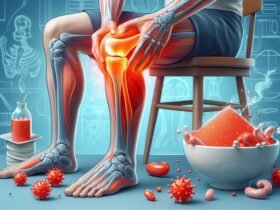Table of Contents
Seed corns on feet can be both uncomfortable and painful. They are small, hardened areas of skin that usually form due to pressure or friction. Luckily, there are several natural ways to treat them at home. This article will guide you through identifying corn seed on feet, using home remedies, and taking preventive measures to keep your feet healthy.
Key Takeaways
Identifying Seed Corns on Feet

Visual Characteristics
Seed corns are small, round areas of dead skin, typically found in clusters on the sole of the foot. They are characterized by a hard central core surrounded by inflamed skin. Unlike other types of corns, seed corns are usually smaller and have well-defined borders.
Common Symptoms
Common symptoms of seed corns include:
These symptoms can make it difficult to differentiate seed corns from other foot conditions.
Differences from Other Foot Conditions
Seed corns can be confused with other foot conditions like calluses and plantar warts. However, there are key differences:
It’s important to correctly identify seed corns to ensure proper treatment and relief.
Home Remedies for Treating Corn Seed on Feet
Using Natural Moisturizers
Regularly moisturizing your feet can help soften the skin and prevent corns from forming. Aloe vera gel is a great option because it has healing properties and can reduce inflammation. Apply a spoonful of aloe vera gel to the affected area daily.
Foot Soaking Techniques
Soaking your feet in warm water can soften the skin, making it easier to remove corns. Add a mixture of apple cider vinegar, lemon juice, and water to the soak for better results. Leave your feet in the soak for 15 minutes, then gently rub the corn with a pumice stone.
Exfoliation Methods
Exfoliating your feet helps remove dead skin cells and can prevent corns. Use a pumice stone or foot brush after soaking your feet. Be gentle to avoid injury. Regular exfoliation can keep your feet smooth and corn-free.
Initiating these home remedies can alleviate the hardness of the corns, reducing discomfort while walking. With consistent use, an improvement can be noted within a week.
Over-the-Counter Treatments for Seed Corns
Salicylic Acid Products
Over-the-counter products can be very effective in treating seed corns. These products often contain salicylic acid, which helps soften the skin of corns and makes them easier to remove. Some popular options include:
Using these products can reduce the size of corns and make them less painful. However, avoid using them if you have diabetes or poor blood flow.
Medicated Pads and Patches
Medicated pads and patches are another great option for treating seed corns. These pads offer relief from corn discomfort and ensure holistic comfort with every step you take. They are easy to apply and can be worn throughout the day to provide continuous treatment.
When to Use OTC Treatments
Over-the-counter treatments are best used when seed corns are small and not too painful. If the corns are persistent or very painful, it might be time to see a doctor. Always follow the instructions on the product packaging to avoid any side effects.
If you notice any signs of infection, such as redness, warmth, or swelling, stop using the product and consult a healthcare professional immediately.
Preventing Seed Corns from Forming

Choosing Proper Footwear
To prevent seed corns, wearing comfortable shoes that fit properly is crucial. Here are some tips:
- Good fit: Ensure your shoes fit well without your foot sliding back and forth.
- Toe room: Make sure you can wiggle your toes comfortably.
- Low heels: High heels add extra pressure to your feet.
- Breathable materials: Choose shoes made from materials like genuine leather.
Daily Foot Care Routine
A consistent foot care routine can help keep seed corns at bay. Follow these steps:
Managing Underlying Health Issues
Certain health conditions can make you more prone to seed corns. Manage these conditions to prevent corns:
Regular self-inspection of your feet can help catch early signs of seed corns, calluses, or other issues before they become problematic.
When to Seek Professional Help
Signs of Infection
If you notice any signs of infection around a seed corn, it’s crucial to seek professional help. These signs include:
An open tissue surrounding corns and calluses can lead to infections by allowing bacteria to enter, potentially causing pain and difficulty walking.
Persistent or Painful Corns
Home remedies might not always work. If there’s no improvement in seed corn symptoms after trying home treatments, it’s important to consult a professional. A professional diagnosis may be required to differentiate seed corns from warts, calluses, or other skin conditions.
Consulting a Podiatrist
If you’re experiencing a corn for the first time or if home treatments haven’t managed foot calluses or corns, it’s time to see a podiatrist. Regularly consulting with a podiatrist can provide personalized advice and treatment options tailored to your specific needs.
Recognizing when to consult a professional for seed corns is vital. If symptoms persist or worsen despite home treatment, or if there are signs of infection, it’s time to consult a podiatrist or foot specialist.
The Role of Footwear in Managing Seed Corns
Proper footwear is crucial in managing and preventing seed corns. Wearing comfortable, well-fitting shoes can significantly reduce the risk of developing these painful spots on your feet. Here are some key points to consider:
Importance of Proper Fit
Shoes that fit well are essential. If your shoes are too tight, they can compress your feet, while loose shoes can cause your feet to slide and create friction. Both scenarios can lead to the formation of seed corns. Make sure your shoes have enough room for your toes to wiggle comfortably.
Materials to Consider
Choose shoes made from breathable materials like genuine leather. These materials allow your feet to breathe and reduce moisture buildup, which can help prevent seed corns. Additionally, features such as arch supports and cushioning can provide extra comfort and reduce pressure on your feet.
Using Inserts and Pads
Using inserts and pads can help alleviate pressure and friction on specific areas of your feet. These can be particularly useful if you have to stand or walk for long periods. Inserts and pads can provide an extra layer of protection and comfort, helping to manage and prevent seed corns.
To manage seed corns, it is important to wear comfortable, well-fitting shoes and use protective pads. Regular foot care and avoiding activities that put excessive pressure on your feet can also help in preventing seed corns.
Natural Ingredients for Seed Corn Relief

Aloe Vera
Aloe vera is a fantastic remedy for seed corns due to its healing properties. It contains vitamins A, C, E, and B-complex, along with folic acid, potassium, and magnesium. These nutrients help reduce inflammation and promote skin healing. Apply a spoonful of aloe vera gel to the affected area daily for the best results.
Apple Cider Vinegar
An apple cider rinse can be very effective in treating seed corns. Mix two tablespoons of apple cider vinegar, lemon juice, and water to create a paste. Apply this paste to the corn and leave it on for 15 minutes before rinsing off with warm water. This method helps soften the corn, making it easier to remove.
Lemon and Onion Treatments
Lemon juice is known for its antiseptic and anti-inflammatory properties. Soak your feet in lukewarm water, then apply lemon juice to the corn. Repeat this process until the corn softens and falls out. Onions, rich in powerful acids and nutrients, can also help. Apply onion juice to the affected area and cover it with a cloth for at least two days to soften the hard skin.
Initiating these home remedies can alleviate the hardness of the corns, reducing discomfort while walking. With consistent use, an improvement can be noted within a week.
Barley Grass Powder
While not as commonly known, barley grass powder can also aid in treating seed corns. Its rich nutrient profile helps in skin repair and reduces inflammation. Mix barley grass powder with water to form a paste and apply it to the corn.
Additional Tips
Conclusion
Taking care of seed corns on your feet naturally is all about consistency and patience. By regularly moisturizing, exfoliating, and choosing the right footwear, you can manage and even prevent these pesky spots. Home remedies like using apple cider vinegar, aloe vera, or lemon juice can also be effective. Remember, if your seed corns persist or become painful, it’s important to seek advice from a healthcare professional. With the right approach, you can keep your feet healthy and comfortable.
Frequently Asked Questions
What are seed corns on feet?
Seed corns are small, hard bumps that usually form on the soles of your feet. They are often caused by pressure or friction from poorly fitting shoes and can be painful when pressed.
How can I treat seed corns at home?
You can treat seed corns at home by soaking your feet in warm, soapy water, using a pumice stone to gently file away thickened skin, and applying a moisturizer to keep your feet soft. Over-the-counter products with salicylic acid can also help.
What natural remedies can help with seed corns?
Natural remedies for seed corns include using aloe vera gel, applying a paste made from apple cider vinegar and lemon juice, and soaking your feet in warm water mixed with Epsom salts.
How can I prevent seed corns from forming?
To prevent seed corns, wear well-fitting shoes with plenty of toe room, keep your feet clean and moisturized, and use pads or inserts to reduce pressure on specific areas of your feet.
When should I see a doctor for seed corns?
You should see a doctor if your seed corns are very painful, show signs of infection, or do not improve with home treatment. People with diabetes or poor circulation should consult a doctor before trying any home remedies.
What is the difference between seed corns and plantar warts?
Seed corns are small, hard spots that usually form on the soles of the feet and are caused by friction or pressure. Plantar warts, on the other hand, are caused by a viral infection and often have tiny black dots in the center.














Leave a Review